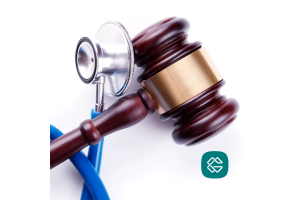Can E-Signatures Be Used Under HIPAA? A Complete Guide
In the healthcare industry, the use of e-signatures has become increasingly popular, offering an efficient way to manage paperwork and streamline processes. However, given the sensitive nature of the information involved, healthcare providers must ensure that their use of e-signatures complies with the Health Insurance Portability and Accountability Act (HIPAA).
What Is HIPAA and Why Does It Matter for E-Signatures?
The Health Insurance Portability and Accountability Act (HIPAA) sets strict standards for protecting the privacy and security of Protected Health Information (PHI). When using e-signatures, it is crucial to ensure that they comply with HIPAA’s confidentiality and security requirements.
While HIPAA does not specifically mention e-signatures, the U.S. Department of Health and Human Services (HHS) has issued guidance clarifying that e-signatures can be used in the healthcare setting, as long as certain conditions are met.
Key Considerations for Using E-Signatures in Healthcare
There are a few essential requirements for using e-signatures while ensuring HIPAA compliance:
- Authentication: The identity of the signatory must be verified to prevent unauthorized access and ensure that the person signing is authorized to do so.
- Data Security: All documents containing PHI should be securely encrypted during transmission and storage. Unauthorized individuals should not be able to access or alter the information.
- Legal Compliance: The electronic signature must comply with not only HIPAA but also applicable state laws and other relevant regulations, including ensuring that the e-signature holds up in a court of law.
Common Uses of E-Signatures in Healthcare
E-signatures are now widely used in healthcare for various activities. Some of the most common applications include:
- Patient Consent and Authorizations: Patients can sign forms that give their consent for treatments or allow the use of their PHI for specific purposes.
- Telehealth Verification: E-signatures are often used to confirm patient identity before a virtual consultation.
- Business Associate Agreements (BAAs): Healthcare organizations can use e-signatures to formalize agreements with third-party vendors, ensuring both parties are HIPAA-compliant.
- Consent for Medical Procedures: E-signatures allow patients to give remote consent for medical procedures, including potential risks involved.
- Acknowledgments of Privacy Practices: Patients can electronically sign an acknowledgment that they have received the healthcare provider’s privacy practices.
The Legal Framework for E-Signatures Under HIPAA
The U.S. government recognized the growing need for digital signatures early on. Originally, the HIPAA Security Rule draft included provisions for digital signatures, considering them a secure method to authenticate documents in healthcare transactions. However, this provision was ultimately removed due to concerns about the technology’s maturity and security risks.
Later, HHS issued guidance that acknowledged the legality of electronic signatures, provided they meet the conditions set forth by both HIPAA and state laws. For example, the signing of Business Associate Agreements (BAAs) via e-signatures has been explicitly permitted, as long as the agreement complies with contract law.
Proposed Rule Changes and Future Impact on E-Signature Use
In 2022, the Centers for Medicare & Medicaid Services (CMS) proposed new rules aimed at standardizing the use of e-signatures in healthcare attachment transactions. These transactions include situations where healthcare providers must submit additional information to health plans for prior authorization or claim determination.
The proposed rule would make it possible for these transactions to occur electronically, streamlining the process and reducing the time and cost associated with traditional mail or fax submissions. However, in order to ensure security, these transactions would need to be signed using a digital signature that includes robust encryption and user authentication protocols.
While this proposed rule doesn’t mandate the use of e-signatures for all healthcare transactions, it signals an increased push towards digital solutions in healthcare, and it may serve as a stepping stone for expanding e-signature use across more areas governed by HIPAA.
Best Practices for Ensuring HIPAA Compliance with E-Signatures
To make sure that your e-signature practices are HIPAA-compliant, consider the following best practices:
- Use Trusted E-Signature Platforms: Choose an e-signature solution that adheres to the highest security standards and offers features like encryption, audit trails, and strong authentication methods.
- Ensure Encryption of PHI: All PHI must be encrypted both during transmission and storage to prevent unauthorized access.
- Conduct Regular Security Audits: Periodically review your e-signature processes to ensure they remain compliant with HIPAA requirements, particularly as technology and regulations evolve.
- Provide Clear Authentication Processes: Before a signature is applied, verify the identity of the signer, especially when it involves sensitive information like medical records or consent forms.
- Document Retention and Backup: Store signed documents securely and ensure that backup systems are in place to prevent data loss.
The Future of E-Signatures in Healthcare
As digital transformation continues to shape the healthcare landscape, the adoption of e-signatures is expected to grow, provided that healthcare organizations stay compliant with HIPAA and other regulations. The CMS’s proposed changes could pave the way for more standardized use of e-signatures across different healthcare processes, further driving efficiency and improving patient care.
Conclusion
E-signatures offer a convenient and efficient solution for handling various healthcare documents, including consent forms, authorization forms, and more. By adhering to HIPAA's requirements for authentication, security, and legal compliance, healthcare organizations can use e-signatures while safeguarding patient privacy. As regulations evolve, staying informed and adopting best practices will be key to maintaining compliance and leveraging the full benefits of digital signatures in healthcare.





